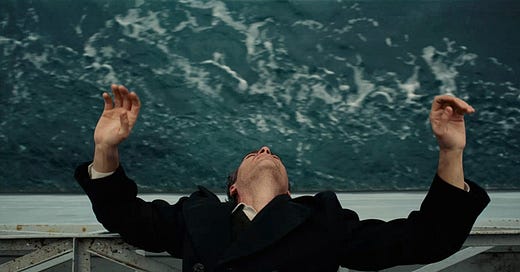"For the Culture" Screen Review: The Master (2012)
A Traumatized World War II Vet, A Cult Leader, and Their Crazy Bro-Mance
Acclaimed director Paul Thomas Anderson has always embraced eccentric character studies. Indeed, his film leads include adult film stars (Boogie Nights), a depressed toilet plunger salesman (Punch-Drunk Love), and sociopathic oil barons (There Will Be Blood). Yet, despite a focus on the peculiar crowd, Anderson avoids exploitation or caricature. Indeed, he humanizes these odd subjects by giving them realistic and (mostly) sympathetic character arcs. This strategy faces its greatest challenge with 2012's The Master. The film forces Anderson to paint a thematic portrait of two deeply contradictory men: a charismatic cult leader and an addiction ravaged World War II veteran. However, it is precisely his beautiful and empathetic entwining of these character foils that makes the film truly great.
The Master begins in paradise. Our protagonist, Freddie Quell (Joaquin Phoenix), is a young American sailor during the final days of the Pacific War. As peace approaches, Freddie and his comrades frolic on a tropical beach where they horseplay, devour coconuts, and mold "suggestive" sand mermaids. Yet, amidst this tropical bliss, the black cloud of trauma hangs heavily over Freddie. Like many others veterans, his brutal combat experience has made him prone to arbitrary violence, drunkenness, and aggressive sexuality. These antisocial tendencies land Freddie in a military psychiatric hospital when the war closes. Yet, despite displaying continued erratic behavior, exhausted doctors quickly release him into the shining streets of late-1940s America.
Naturally, Freddie's alcoholism and violent outbursts make holding steady work impossible. First, he's fired as a department store photographer after beating up a random customer. Then, he loses a low-level agriculture gig when his bootleg liquor poisons a fellow farmhand. This last incident lands Freddie at rock bottom. Now living on the streets and penniless, he roams the city docks until breaking into a yacht for some shut-eye. Yet, upon being discovered, the drunken stowaway is treated with unusual kindness by the passengers. Indeed, rather than contacting the authorities, these friendly strangers introduce Freddie to their charming leader, Lancaster Dodd (Philip Seymour Hoffman). Dodd's cheery followers proudly call him “The Master”.
Despite their stark differences, Dodd and Freddie form a quick bond. Both men are quick-tempered boozers who take great delight in Freddie's bootleg concoctions. Dodd soon indoctrinates the impressionable war veteran into his “philosophical” group: The Cause. Similar to real-world Scientology, The Cause emphasizes unburdening previous traumas to connect individuals with their better "past lives” and increase "consciousness." Therefore, all Cause members conduct therapy sessions called "Processing," in which they must answer a set of increasingly personal questions instantly and truthfully. Only after confronting the traumas acknowledged during this exercise can devotees access different versions of themselves across time and space through the higher “mental state” gained.
Freddie receives a less warm welcome from The Master's cold but intelligent wife, Peggy (Amy Adams). Indeed, Peggy instantly recognizes Freddie as an unstable drunk whose irregularity risks damaging The Cause's fragile reputation. Yet, expelling Freddie becomes nearly impossible as the war veteran assumes the dual-positions of Dodd's confidant and attack dog against perceived enemies. Thus begins a subtle but tense power struggle for the fate of our damaged protagonist and the rapidly growing cult he has adopted.
The question the movie compels us to examine revolves around who the real “Master” is. The film initially presents The Cause's eloquent leader, Lancaster Dodd, as the obvious answer. Yet, as the plot progresses, it becomes clear that Dodd is a giant with clay feet. Indeed, the ego-filled cult leader is dissolute, petulant, and often in legal trouble for unethical behavior. Looking past Dodd's troubled facade, another contender for the Master title appears: Peggy. During the film's climax, it becomes clear that Peggy both sexually controls Dodd and serves as the principal author for The Cause's elaborate ideology. Peggy's stature is also displayed when she deftly sways the cult against Freddie despite her powerful husband's protests.
Yet, this last sentence reveals the last, and I believe, the best candidate for the film's true Master: Freddie himself. When the movie begins, Freddie is little more than an unhinged brute driven only by sex and alcohol. He does not seek healing for past war traumas or acknowledge how his destructive actions affect others. Yet, after becoming Dodd's henchman, Freddie regains a long-lost sense of structure and purpose. However, this newfound motivation comes at the dire cost of his autonomy. More alarmingly, the restrictive environment provokes a new conflict as Freddie’s addictive personality grows more restrained. Indeed, the now- partially sober Freddie begins fixating on rekindling a relationship with his pre-war love interest, Doris (Madisen Beaty). Yet, reuniting with Doris would mean abandoning The Cause, as the group expects total devotion. Ultimately, Freddie makes a permanent and difficult decision that completes the film's story arc. Through choosing rather than being guided by his addiction or other people, Freddie finally becomes "The Master" of his own life. It is a beautiful tale of self-actualization that exemplifies Paul Thomas Anderson's talent for illuminating the quiet desperations and triumphs of the human experience .




